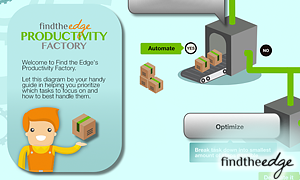 We live in a time when technology has given all businesses – from independent consultants to large corporations – the ability to make a massive impact with their brand in a matter of months, not years.
We live in a time when technology has given all businesses – from independent consultants to large corporations – the ability to make a massive impact with their brand in a matter of months, not years.
Yet so many companies seem to struggle with the change of approach they need to harness the new marketing and selling environment we're in.
At a creative session with my editor when I was writing my book, I found myself trying to distil ‘the Principled Selling approach' into as few words as possible. The result was:
‘Generate, Motivate, Secure, Develop’
Four words that sum up the business development activity all businesses which want long-term profitable relationships need to focus on.
1. Generate
Generating the right number of enquiries from the right profile customers and clients is the first step to building a great client base.
Long-term profitable growth depends on selling products and services to clients and customers who buy and then re-buy.
Finding the right prospects in the right numbers has never been easier if you apply new thinking to your marketing activity, and adopt the content marketing mind-set.
Ditching expensive brochures and marketing materials for well thought out content – which is shared through social media channels – enables reputations and brands to rapidly establish.
In an era where trust in anyone ‘selling’ is at an all-time low, you can now build trusted relationships with target markets – and even individual senior decision makers – in ways that traditional marketing and selling has never been able to.
Despite what used to be said – it doesn’t take long to build trust. Buyers are actively seeking trusted suppliers all the time.
Marketing is no longer about mass production of propaganda, or telling your story in the hope that someone who is ready to buy will listen – it's all about motivating potential customers to actively engage with you.
A brand and reputation is no longer what we say it is. It's what our customers and market tell each other it is via their social networks, both online and offline.
2. Motivate
Most long-term relationships involve at least one face-to-face meeting, and relationships can be won or lost in a less than sixty minutes.
Traditionally this was when the ‘selling’ started.
There are so many myths about ‘selling,’ and so much bad press about salespeople, that it isn’t really a surprise that a great deal of those who need to win business hate the idea of having anything to do with the practice of ‘selling'.
Yet selling is no more than the exchange of goods and services for money. There's nothing to stop it from being a really comfortable and natural experience for both the seller and the buyer.
There are principled skills and behaviours involved that can motivate customers to buy if selling is conducted ethically, with integrity, and with a conscience.
Clients no longer need a salesperson to explain a product or service. Instead, they can do their own research online and compare suppliers in an instant.
What they do want, is someone who can really understand them, and who can help them achieve their organisation's critical success factors.
Knowing how to get proposals, RFT’s and presentations right is also important. You'd be surprised how many suppliers still get the basics wrong.
3. Secure
Holding on to existing customer and client relationships has never been so important.
Managing the customer’s experience of doing business with you, having objective measurements of the strength of relationships, and delivering as promised, all contribute to building customer loyalty.
In a world where there is so much competition, there is a need to put at least as much effort into securing existing relationships as competitors put into trying to attract your best customers!
Sharing valuable content with existing clients is just as important as using it to attract new clients.
4. Develop
Doing a great job for customers is no guarantee that they will continue buying from you, or that they will buy your complete range of services or products.
Developing new opportunities with existing customers requires as much planning and business development activity as winning new clients.
If you have major accounts or key clients, having a two-page action plan for how you can grow new opportunities is much more important than static data kept on a CRM system.
In my experience, the organisations that sustain sales growth understand where they need to focus their resources and energy. It's into generating new customers, winning orders or instructions, securing existing customers, or developing new opportunities.
The best have strategies and actions plans for all stages of the business development process.





